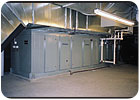
The Wynn Las Vegas is a 50-story-tall structure. The hotel, designed by Steve Wynn, was the first mega hotel to be built in Las Vegas in the past five years. Taking the place of the Desert Inn, which was torn down in 2001, this $2.7 million hotel is designed to surpass the Bellagio, the Mirage, and Treasure Island, all of which Steve Wynn designed.
Acclaimed show creator Franco Dragone conceived performers braving the elements of rain and fire indoors at the 3,000-seat Le Reve, an aquatic theatrical extravaganza at the Wynn Las Vegas. Principal mechanical engineer jba Consulting Engineers, consulting engineer Brad Geinzer, and Hansen Mechanical Contractors, Las Vegas, had to tame Le Reve’s special effects and provide indoor comfort. Mitch Trageton, Marnell Architecture, Las Vegas, was the project’s architect.
“This was one of my most technical projects,” said Geinzer, whose firm has had an HVAC design hand in other high-tech Las Vegas theatrical venues, such as the Caesar’s Palace Coliseum and multiple Cirque du Soleil showrooms.

Renowned show creator Franco Dragone had the idea of acrobatic performers who would brave the elements of rain and fire indoors at the 3,000-seat Le Reve, an aquatic theatrical extravaganza at the Wynn Las Vegas.
MONSTROUS MOISTURE
The main 8,200-square-foot, 1.1-million-gallon performance pool presented something of a nightmare for evaporation and humidity control all by itself.The 32,000-square-foot theater in the round, however, also includes an 80-foot-high rainstorm, an authentic boiling effect that sends bubbles and moisture roaring out of the pool, and an assortment of water cannons and other aquatic effects, not to mention supplemental staging pools.
All totaled, the dehumidification system had to control 950 pounds/hour of moisture produced by the elements of the show.
The design is anchored by two 32,000-cfm, Model DB-5362 and two 11,000-cfm, Model DB-5120 Dry-O-Tron® dehumidifiers manufactured by Dectron Inc. The units serve the aquatic staging areas beneath the seats and the general theater’s dehumidification, heating, and cooling.
WAY BEYOND THE NORM
More conventional natatorium designs, such as community or water park indoor pools, typically offer engineers established statistics on water usage to help them size the equipment properly. Geinzer didn’t have that luxury.“We knew the concept of the effects they were going to use during our HVAC design phase, but we had no idea how long or how much of the effect would be part of the show,” Geinzer recalled. “Basically they wanted to leave open the opportunity for creativity, so they designed the theatrical performance as they went along. Adjustments in the show continue even today.”
In most natatorium designs, space and water temperatures typically have a 2° differential, such as 84° and 82°F respectively, to minimize evaporation.
The Le Reve pool has an 86° water temperature, but the air supplied above the pool is 105° to keep the wet performers warmer. The air is supplied from ductwork and diffusers in a 10-inch-wide pony wall that also serves as a low-rise buffer between the audience and performers.
Three 3,200-cfm York® air handlers, from Johnson Controls, heat the pool’s surface air. “The pony wall serves as an unobtrusive air-delivery system for the performers, and it helps prevent this warmer performance area air from entering the seating area,” said Geinzer.
This also created a huge vapor pressure difference. It required specialized evaporation calculations by jba, assisted by Matt Miceli, sales engineer and manufacturer’s representative at Engineered Equipment & Systems Co., Las Vegas.

The dehumidification system, anchored by Dry-O-Tron, dehumidifiers needed to control 950 pounds/hour of moisture produced by the show. The units serve the aquatic staging areas beneath the seats and the general theater’s dehumidification, heating, and cooling.
SEATING AND CONTROLS
The audience is given cooler air supplied through the foundation of the seating area, which acts as a plenum. These specially designed theater seat diffusers were created by H. Krantz TKT GmbH, Aachen, Germany. Although the system has been used in a variety of applications, the H. Krantz system is said to be ideal for theaters and concert halls because it’s designed to disperse air with such low velocities that the air volume noise is inaudible to the audience.The Le Reve seating area has three separate plenums with eight control zones, each with temperature controlled by sensors interfaced with the hotel’s Invensys direct digital control (DDC) building automation system.
The amount of outdoor air used ranges from 30-50 percent, depending on the required special effects, occupied rates, and time of day. The design from jba - which also provided life/safety, mechanical, electrical, and low voltage engineering for the entire hotel - took advantage of the naturally dry climate to lessen the dehumidification loads of the theater, according to Geinzer.
The DDC presets were programmed by jba and, Invensys representative, Yamas Control Systems Southwest Inc., Las Vegas. These presets are extremely valuable because the show’s diverse elements require different temperature, airflow, and relative humidity set points. For example, one part of the show requires momentary backstage positive pressurization to push a fog effect out to the main performance area.
Such calibrations are made easier because all the air handlers, dehumidifiers, and exhaust fans have Toshiba America variable-frequency drives controlled by the DDC system. “Working around all these possible show conditions without disrupting audience comfort made the project very challenging,” said Geinzer.
One thing jba has learned from other HVAC designs at other Las Vegas aquatic theater shows is that many stagehands operate above the performance action with props and lighting; they also must be provided with separate temperature and humidity control for their respective indoor air comfort.

“Basically they [Le Reve’s producers] wanted to leave open the opportunity for creativity, so they designed the theatrical performance as they went along,” said consulting engineer Brad Geinzer. “Adjustments in the show continue even today.” That means the mechanical systems needed flexibility as well.
SYSTEM EFFICIENCY
With so much going on, system efficiency often suffers, however with this system, this has not been the case. The dehumidifiers employ a heat recovery process; heat is rejected to the theater’s integral water-source heat pump loop, which in turn, is used to heat the pool water.Plate heat exchangers by Alfa Laval provide primary pool water heating. Backup heating from the facility’s central plant is only used when it’s needed. Not having to cool the water-cooled equipment, instead rejecting heat to the loop, also saves energy.
The theater ceiling also employs four exhaust fans by Greenheck. Two fans provide conventional exhaust functions and keep the theater at a negative pressure to eliminate air infiltration into the general hotel. Two other exhaust fans activate for smoke management purposes, to comply with high-rise building requirements (in addition to theater requirements due to the adjoining high-rise guestroom tower).
Aside from humidity, a ring of fire with huge center flames also has an unpredictable effect on airflow throughout the space. Most importantly, the team paid very close attention to exhausting products of combustion during the flame effect.
According to National Fire Protection Association Code 160, Flame Effect Before An Audience, airflows, high/low gas pressure, pilot light operation, and other critical factors are combined by a monitoring system and operator before ignition at each show. Dozens of life-safety sensors for smoke, heat, and flame detection are mounted throughout the seating-performance area and interfaced with the DDC system.
Besides being an engineering feat, the Le Reve has been a great collaboration between architects, consulting engineers, contractors, theatrical designers, and other disciplines to create an aquatic theater masterpiece.
Publication date:03/26/2007

Report Abusive Comment